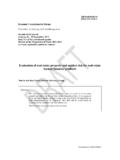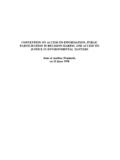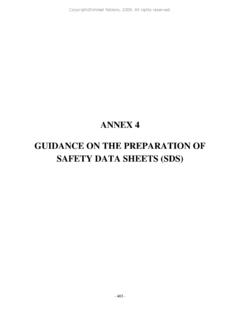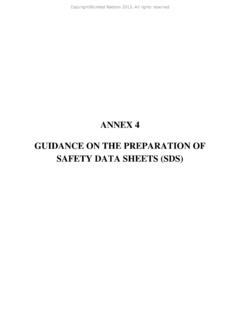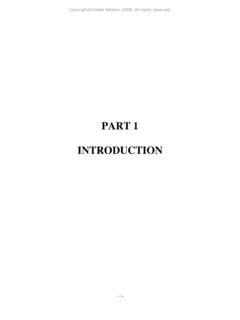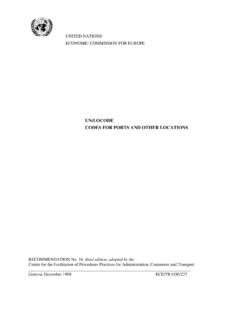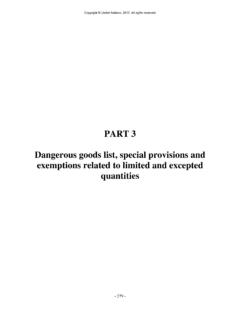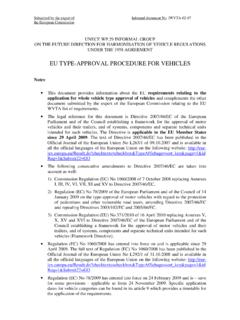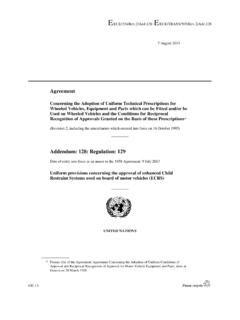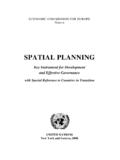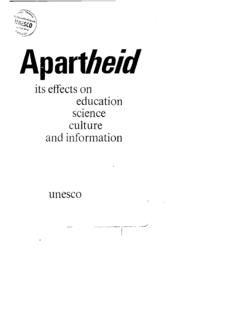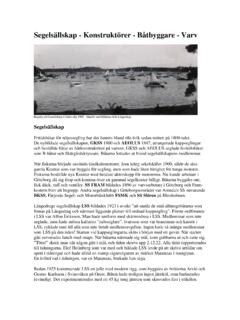Transcription of CHAPTER 2 ECONOMIC GROWTH AND THE …
1 _____45 CHAPTER 2 ECONOMIC GROWTH AND THE environment Theodore Panayotou Introduction Will the world be able to sustain ECONOMIC GROWTH indefinitely without running into resource constraints or despoiling the environment beyond repair? What is the relationship between a steady increase in incomes and environmental quality? Are there trade-offs between the goals of achieving high and sustainable rates of ECONOMIC GROWTH and attaining high standards of environmental quality? For some social and physical scientists such as Georgescu-Roegen55 and Meadows et al.
2 ,56 growing ECONOMIC activity (production and consumption) requires larger inputs of energy and material, and generates larger quantities of waste by-products. Increased extraction of natural resources, accumulation of waste and concentration of pollutants will therefore overwhelm the carrying capacity of the biosphere and result in the degradation of environmental quality and a decline in human welfare, despite rising Furthermore, it is argued that degradation of the resource base will eventually put ECONOMIC activity itself at risk. To save the environment and even ECONOMIC activity from itself, ECONOMIC GROWTH must cease and the world must make a transition to a steady-state economy.
3 At the other extreme, are those who argue that the fastest road to environmental improvement is along the path of ECONOMIC GROWTH : with higher incomes comes increased demand for goods and services that are less material intensive, as well as demand for improved environmental quality that leads to the adoption of environmental protection measures. As Beckerman puts it, The strong correlation between incomes, and the extent to which environmental protection measures are adopted, demonstrates that in the longer run, the surest way to 55 N.
4 Georgescu-Roegen, The Entropy Law and the ECONOMIC Process (Cambridge, Harvard University Press, 1971). 56 Meadows, Meadows, J. Randers and W. Behrens, The Limits to GROWTH (London, Earth Island Limited, 1972). 57 H. Daly, Steady-state Economics (San Francisco, Freeman & Co., 1977); Second Edition (Washington, , Island Press, 1991). improve your environment is to become rich .58 Some went as far as claiming that environmental regulation, by reducing ECONOMIC GROWTH , may actually reduce environmental Yet, others60 have hypothesized that the relationship between ECONOMIC GROWTH and environmental quality, whether positive or negative, is not fixed along a country s development path; indeed it may change sign from positive to negative as a country reaches a level of income at which people demand and afford more efficient infrastructure and a cleaner environment .
5 The implied inverted-U relationship between environmental degradation and ECONOMIC GROWTH came to be known as the environmental Kuznets curve, by analogy with the income-inequality relationship postulated by At low levels of development, both the quantity and the intensity of environmental degradation are limited to the impacts of subsistence ECONOMIC activity on the resource base and to limited quantities of biodegradable wastes. As agriculture and resource extraction intensify and industrialization takes off, both resource depletion and waste generation accelerate.
6 At higher levels of development, structural 58 W. Beckerman, ECONOMIC GROWTH and the environment : whose GROWTH ? whose environment ? , World Development, Vol. 20, No. 1, April 1992, pp. 481-496, as quoted by S. Rothman, Environmental Kuznets curves - real progress or passing the buck? A case for consumption-based approaches , Global Economics, 1998, p. 178. 59 B. Barlett, The high cost of turning green , Wall Street Journal, 14 September 1994. 60 N. Shafik and S. Bandyopadhyay, ECONOMIC GROWTH and Environmental Quality: Time-Series and Cross-Country Evidence, World Bank Policy Research Working Paper, No.
7 904 (Washington, ), June 1992; T. Panayotou, Empirical Tests and Policy Analysis of Environmental Degradation at Different Stages of ECONOMIC Development, ILO Technology and Employment Programme Working Paper, WP238 (Geneva), 1993; G. Grossman and A. Kreuger, Environmental impacts of a North American free trade agreement , The Free Trade Agreement (Cambridge, MA, The MIT Press, 1993); T. Selden and D. Song, Environmental quality and development: is there a Kuznets curve for air pollution emissions? , Journal of Environmental Economics and Management, Vol.
8 27, Issue 2, September 1994, pp. 147-162. 61 S. Kuznets, ECONOMIC GROWTH and Structural Change (New York, Norton, 1965) and Modern ECONOMIC GROWTH (New Haven, Yale University Press, 1966). 46_____Economic Survey of Europe, 2003 No. 2 change towards information-based industries and services, more efficient technologies, and increased demand for environmental quality result in levelling-off and a steady decline of environmental degradation,62 as seen in chart The issue of whether environmental degradation i) increases monotonically, ii) decreases monotonically, or iii) first increases and then declines along a country s development path, has critical implications for policy.
9 A monotonic increase of environmental degradation with ECONOMIC GROWTH calls for strict environmental regulations and even limits on ECONOMIC GROWTH to ensure a sustainable scale of ECONOMIC activity within the ecological life-support A monotonic decrease of environmental degradation along a country s development path suggests that policies that accelerate ECONOMIC GROWTH lead also to rapid environmental improvements and no explicit environmental policies are needed; indeed, they may be counterproductive if they slow down ECONOMIC GROWTH and thereby delay environmental improvement.
10 Finally, if the environmental Kuznets curve hypothesis is supported by evidence, development policies have the potential of being environmentally benign over the long run (at high incomes), but they are also capable of significant environmental damage 62 T. Panayotou, Empirical Tests and Policy , op. cit. 63 K. Arrow, B. Bolin, R. Costanza, P. Dasgupta, C. Folke, C. Holling, B. Jansson, S. Levin, K. M ler, C. Perings and D. Pimental, ECONOMIC GROWTH , carrying capacity and the environment , Science, Vol.
